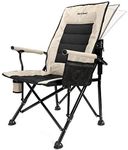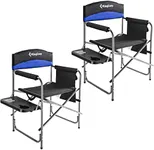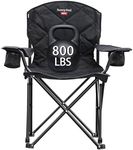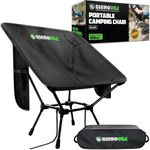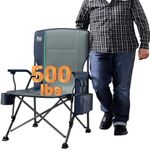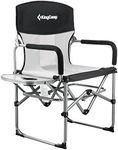Buying Guide for the Best Camping Chair For Heavy People
Choosing a camping chair for heavy people is all about finding a chair that offers both comfort and reliable support. It's important to look for a chair that is sturdy, stable, and designed to handle higher weight capacities. The right chair will make your outdoor experience much more enjoyable, whether you're camping, fishing, or just relaxing outside. Pay attention to the materials, construction, and features that contribute to both safety and comfort.Weight CapacityWeight capacity refers to the maximum amount of weight the chair is designed to safely support. This is crucial for heavy people because using a chair with too low a weight limit can lead to discomfort, damage, or even accidents. Weight capacities are usually listed in pounds or kilograms. Chairs typically range from 200 lbs to over 500 lbs. If you are heavier, always choose a chair with a weight limit well above your own weight for extra safety and durability.
Frame MaterialThe frame material determines how strong and durable the chair is. Common materials include steel, aluminum, and sometimes reinforced plastic. Steel frames are the strongest and can support more weight, but they are heavier to carry. Aluminum is lighter but may not support as much weight unless specially reinforced. For heavy people, a steel frame is usually the best choice, but if you need something lighter for transport, look for high-quality aluminum with reinforced joints.
Seat Width and DepthSeat width and depth refer to the size of the sitting area. A wider and deeper seat provides more comfort and stability, especially for larger individuals. Standard chairs may feel cramped, so look for chairs labeled as 'oversized' or 'extra wide.' If you want to sit comfortably for long periods, make sure the seat is wide enough for your hips and deep enough to support your thighs.
Seat HeightSeat height is the distance from the ground to the seat. A higher seat makes it easier to get in and out of the chair, which is especially helpful for heavier people or those with mobility issues. Lower seats can be harder to rise from. Seat heights usually range from about 15 to 20 inches. If you have trouble standing up from low positions, choose a chair with a higher seat.
Fabric StrengthThe fabric used for the seat and backrest needs to be strong and durable to support more weight. Look for heavy-duty polyester, canvas, or other reinforced materials. The fabric should be double-stitched and have strong seams to prevent tearing. If you plan to use the chair frequently or in rough conditions, prioritize chairs with tough, weather-resistant fabric.
Stability and Leg DesignStability is about how well the chair stays balanced and resists tipping. Chairs with wider bases, cross-braced legs, or anti-slip feet are more stable, especially on uneven ground. For heavy people, a stable chair is essential to prevent accidents. If you often camp on soft or uneven surfaces, look for chairs with wide, sturdy feet and a solid leg design.
Portability and WeightPortability refers to how easy it is to carry and transport the chair. Heavier-duty chairs tend to weigh more, but some are designed to fold compactly or come with carrying bags. If you need to walk long distances with your chair, consider the balance between strength and weight. Choose a chair that you can comfortably carry but that still meets your support needs.


